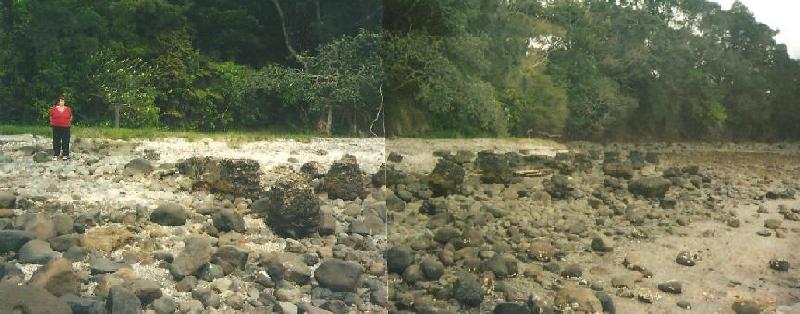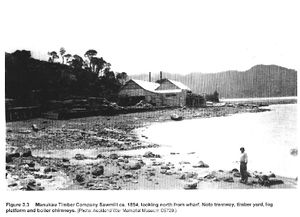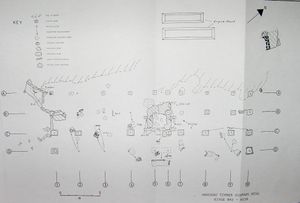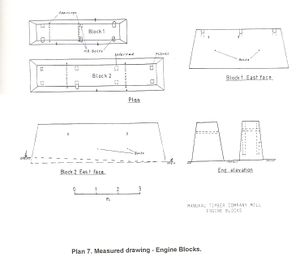Hinge Bay
Contents
Hinge Bay - Manukau Timber Company Sawmill
Hinge Bay is the site of a sawmill built by the Manukau Timber Company. It operated from 1891 to 1895. There was an associated wharf and manager's house. The latter still survivies as part of an outdoors education camp. The mill was built on the water's edge and the surviving remains include the concrete pile foundations and a steam engine foundation.
|
|
There is a guided walk to the site starting at the Huia Museum. The Auckland Regional Council interpretation was undertaken by Caroline Phillips.
The site is scheduled for preservation or protection in the Auckland Regional Plan: Coastal - Site No. 54.
Summary of Manukau Timber Company Sawmill Conservation Plan
A conservation plan was prepared for the Auckland Regional Council by Garry Law, Law Associates Ltd, and John Coster, Heritage Works.
G Law and J Coster 2000 Manukau Timber Company Mill, Hinge Bay, Huia (Site Q11/472) Conservation Plan. Prepared for the Auckland Regional Council, Law Associates Ltd and Heritage Works.
The mill was built partly on concrete foundations in the intertidal zone on a boulder beach. Much of these foundations, some including timber baulks are still insitu. Part of the mill was built on the sandy flat behind the beach. An engine foundation exists in that situation as well as what apears to be a base for the boiler. The mill utilised kauri logs from the Waitakere Ranges behind the bay. These were driven by timber dams down several streams. The main source is believed to be the Karamatura Stream, with the logs caught in a boom at the sea front, floated around to the mill and hauled up a ramp to the mill floor. The milled timber was stacked to the west of the mill and shipped out via a light tramway to the wharf. The wharf would not accomodate anything but small vessels. Some timber was shipped by floating baulks out to larger ships.
The machinery is believed to have been erected previously at Karakare. A similar engine base exists there. With a large flywheel the engine was of a dated design when it was erected here. The double chimneys on the historical photograph suggest there were two boilers in use.
The mill was in competiton with a much larger mill at Onehunga - also on the Manukau Harbour edge. The has the advantage of road and rail access to central Auckland fopr its products and no doubt a bigger labour pool. Much larger vessels couls also bring logs to Onehunga so its source of timber was also wider. This was the pattern generaly in the Kauri industry - a move to bigger vessels - mostly scows - and large centralised mills. The large mills also had capacity for making weatherboards and joinery mouldings and hence satisfying more of the market. Ths combined with the current economic depression pushed the Manukau Timber Company into receivership. The mill equipment was sold and moved to Waitakere.
There was no sawdust of ash residue at the site suggesting this had been disposed of into the sea. There was no coal waste at the site so the boiler firing was very likley to have been entirely from off-cuts.
After its use the site was used for batches by people without any formal right to use the site. These had been removed when the ARA took over the land behind the bay as a regional park.
The survey noted some areas of concrete with different constituents from the foundation blocks. These appear to have been later additions to form seawalls for the grounds of the batches.
The batch use may have caused some disturbance to the beach terrace and possibly to any archaeology in this area. Several of the foundation blocks had been tipped over. Anecdotal evidence poined to a fairly recent storm as causing this damage and some erosion to the beach terrace.
A conservation policy was rcomentded. Recomendations were made for interpretation.
Since the plan was prepared further of the foundation blocks have been tipped - presuma
Location and Date
<googlemap lat="-37.007179" lon="174.563549" zoom="17"> -37.006657, 174.56416, Sawmill site -37.007539, 174.563785, Wharf site -37.007556, 174.563141, Mill manager's house</googlemap> |
Type
The site is a steam powered sawmill and related wharf.
Team
- John Coster
- Kate Hill
Artefacts
Small Collection of artefacts- Xx.jpg
- Yy.jpg
Documents
Conservation Plan: G Law and J Coster 2000 Manukau Timber Company Mill, Hinge Bay, Huia (Site Q11/472) Conservation Plan. Prepared for the Auckland Regional Council, Law Associates Ltd and Heritage Works, (unpublished).



